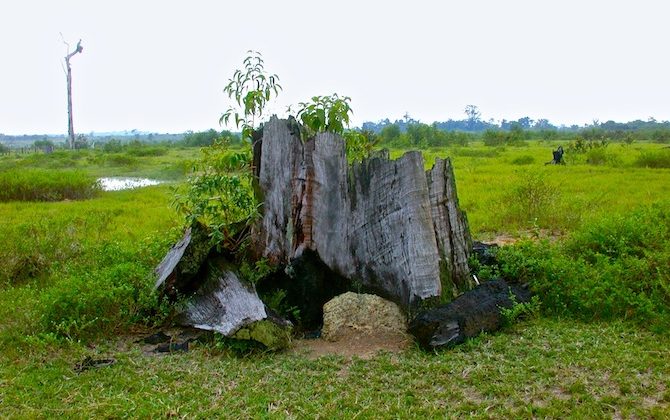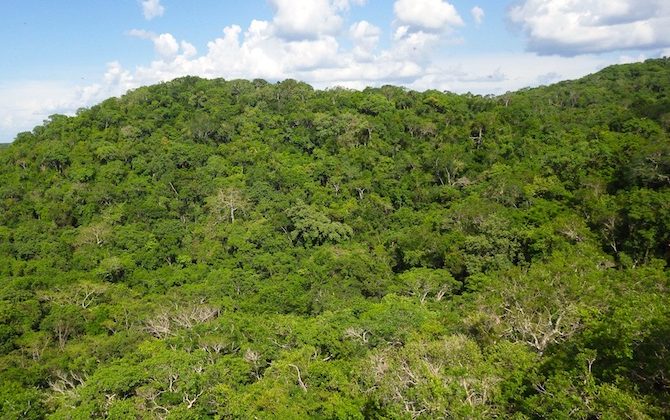By Robin L. Chazdon
Executive Director, Association for Tropical Biology and Conservation
A recent study published online in Science reported that tropical forests globally lost substantially more carbon than they gained from 2003-2014. This robust analysis provokes a shocking and sobering realization of the impact of human activities on the world's most biodiverse biome. Deforestation and large-scale disturbance of tropical forests are legacies of millenia of human civilization. But the scale of these activities may have reached a historical threshold. Although we knew about the deforestation, now we also have a quantitative assessment of the carbon lost through forest degradation that has been ongoing for many decades in the tropics. Tropical forests, long viewed as the lungs of the earth, constitute a critically important global repository of carbon in addition to their irreplaceable biological jewels. Another recent study shows that intact forest landscapes in the tropics are eroding, reducing core habitats for species and indigenous people. It appears that by all counts, tropical forests and their landscapes are losing the battle against the forces of deforestation and forest degradation. Overall, more than half of the carbon losses over these twelve years resulted from selective logging and burning, which have eliminated trees without completely eliminating the forest. These activities continue to dominate land-use narratives across the tropics, despite unprecedented momentum and political will to halt deforestation and forest degradation by 2030, as expressed by the New York Declaration on Forests, signed by 190 countries and companies, and the Paris Climate Agreement, ratified by 166 countries.
How can we reconcile massive global commitments to reduce tropical deforestation and degradation and their associated carbon emissions with the results of this study? Clearly, international conventions, national policies, and industry commitments to protect intact forests and reduce forest degradation have yet to show complete effectiveness on the ground. A recent report shows that commitments to eliminate deforestation and forest degradation from supply chains have not yet led to sustained action. While progress is slowly being made to reduce deforestation for specific commodity chains, the rate of progress has not kept up with rates of forest loss. We still have 12 years to go to reach 2030. Now that the methods are more fine-tuned, forest carbon density can be tracked with ever increasing precision and accuracy. But who will be held accountable for making good on commitments?

Tropical forest converted to pasture in Central Amazonia of Brazil (photo by Robin L. Chazdon).
Forests have an answer. If left on their own, deforested areas will begin to regenerate, accumulating carbon as trees reestablish.
And what is the potential to reverse these changes and to restore tropical forests as significant global sinks for carbon? Forests have an answer. If left on their own, deforested areas will begin to regenerate, accumulating carbon as trees reestablish. And in most cases, forests that have been subjected to fires and selective logging will recover, and they will accumulate large amounts of carbon above the ground. Forests can also be assisted in their recovery, through tree planting and active protection from fire, invasive weeds, and grazing. The rates of recovery processes depend on space, time, and climate; the balance between being a global sink and a global source is determined by how many pixels are being stripped of their forests or losing trees and how many pixels are recovering, at what stage of recovery they are in, what climate zone they are in, and how long they are able to continue their recovery. Another study estimated that in 2008, second-growth forests (1 to 60 years old) covered 2.4 million km2 of land (28.1% of the total study area) in the American tropics, and that if these forests were allowed to continue their recovery over 40 years they would collectively accumulate as much carbon as was emitted from 1993-2004 from fossil fuel burning and industrial processes over all of Latin America and the Caribbean.

Tropical dry forests in Kaxil Kiuic Biocultural Reserve in Yucatán, Mexico have coexisted with humans for millenia (photo by Robin L Chazdon).
We must find ways to cease doing harm to tropical forests and to restore damaged forests and landscapes. The Bonn Challenge to restore 350 million-hectare of forest landscapes globally by 2030 could sequester up to 1.7 gigatonnes of carbon dioxide equivalent annually while also generating US$ 170 billion per year in net benefits from watershed protection, improved crop yields and forest products. Tropical forests can quickly switch from becoming a global sink (accumulating carbon) to becoming a global source (losing carbon), depending on the year and the location. The switch can go both ways—only the gains occur far more slowly than the losses. And if intact forests continue to fall and become reduced to isolated remnants, not only carbon, but species, ways of life, and many ecosystem services will also be lost. We could reach a tipping point where the ability of forests to recover becomes compromised. Fortunately, we have not yet reached that point, but we may be getting close. In many parts of the tropics, such as Brazil's Atlantic Forest Region, less than 10% of the forest remains, and most of this forest hangs on precariously in small remnants.
Complacency on this issue must be transformed to urgent action. Now is the time to work as never before to protect and restore tropical forests. We have seen that business as usual will not solve this problem. We need new approaches to sustainable development that value natural capital. We need to go beyond commitments and beyond planning to implement socially, economically, and ecologically acceptable long-term solutions at local, regional, national, and global levels. Both conservation and restoration are needed on an unprecedented scale and in integrated ways to restore the tropics as global sources of carbon, biodiversity, cultures, and inspiration. We mustn't lose hope, as we still have a chance to save the world's tropical forests and restore faith in humanity.
Reference: Baccini A., Walker W., Carvalho L., Farina M., Sulla-Menashe D., Houghton R. A. 2017. Tropical forests are a net carbon source based on aboveground measurements of gain and loss. Science. Published online September 28, 2017. doi: 10.1126/science.aam5962.



